
The Garold Wayne Interactive Zoological Park - June 21, 2014
By Chris
The Garold Wayne Interactive Zoological foundation is an unforgettable experience. I begin by parking the car alongside a dirt farm-to-market
road right off of the freeway, for although there is a booming crowd of several dozen people today, the park has no parking lot.
As we push through the noisy crowd of tourists, I have to stop and stare at a number of strangely political ads. "PETA Kills!" cries one poster.
"The US Humane Society is a $15 million SCAM!" shouts another. The entire atmosphere is very seedy and leaves me feeling somewhat uncomfortable.
We have a few minutes before our tour is scheduled to start, so we take a quick look around the front of the self-guided part of the park.
The main exhibit is a large grassy field, dotted by small concrete bunkers and surrounded by a chemical-green stagnant moat. We climb up a rickety metal
ladder onto an observation platform built of plywood that bends disturbingly under our feet. Several tourists find this too unsettling for them and immediately
climb back down but we look down across the field at maybe half a dozen large adult tigers on display. They are, for the most part, either motionless on
top of the concrete bunkers or trying to cool themselves in the cloudy blue-green water. They look happy enough, aside from the heat and the flies that
pervade the entire zoo.

Tiger Cooling Off In Murky Water
Soon it is time for the tour to start and we head back down. A park employee confiscates our cameras and cell phones, “for the safety of the animals, of course”.
After what seems like an eternity of cramming too many people into an unventilated tin hut with wooden bleachers, we finally meet the star of the park – the
self-proclaimed "Tiger King" Joe Exotic. Stephanie was unable to get a picture of him, due to photography restrictions. However, a quick search for "Joe Exotic"
will yield plenty of results.
Joe Exotic is not what you would expect a park ranger to be. He is skinny but muscular, with his sleeveless shirt displaying forearms covered in black tattoos.
He wears a ball cap over his bleached, mullet-ish two-toned hair. He has several piercings on his face. Strangest of all (or perhaps not) is when he speaks,
it is a high-pitched country twang that you would never expect to be talking about tigers and lions.
Joe quickly launches into his explanation of the park. It is dedicated to the memory of his brother who was killed by a drunk driver in Dallas, he says.
The whip in his hand is to scare away the chickens, which the tigers are deathly afraid of (he gets a laugh at this but I don't see the humor in such an obvious lie)
and the revolver on his belt is for trespassers. He tells a story of how animal rights activists broke into his zoo one night and poisoned his chimpanzees because
they think they are better off dead than in a cage. The rage in his voice is not an act and I quite believe his claim, "from now on, after dark I'll shoot first
and ask questions later."
For the next part of the speech, Joe attempts to bring out some tigers. However, they cower from him and do not want to follow. He grabs one on a leash and drags
it onstage; the other shrinks away and eventually he gives up and continues on with just one. He says that they house some 140 big cats here, and explains the
difference between rescue (saving a cat in imminent danger of death) and rehome (taking a healthy cat that must leave its existing location do to a change in circumstance,
such as new laws or a lack of money). He speaks out against "giving strangers on the internet your money". Sound advice, but I find it strange for a somewhat shady
donation-based organization to so quickly bring up scams.

Distressed and/or Overheated Tiger
Next, we shuffle out of the tin building and back over to the main tiger pit. Joe has disappeared, and our main tour guide reads a canned script from a sheet of paper.
It consists of some nonsense about trying to breed lions and tigers back together in order to recreate what a sabre toothed tiger would have looked like, all within
four to six generations. The liger he entices to the gate with some raw chicken is an impressive animal, some 900+ pounds of raw strength and very healthy looking.
But I am still disturbed that people with such confused ideas about how genetics work are in charge of this facility, and hope the other patrons are equally wary.
The following few hours are a whirlwind of activity. We see miniature ponies, feed a camel, hold a very distraught baby alligator trying to call for mom, and pet
some docile and obviously low-content wolf hybrids. One particularly enlightening part comes when Joe reappears to tell us the story of a lion born with some metabolic
bone disease (due to mother who, when rescued, was severely malnourished) who grew up with a litter of dachshund puppies. Sure enough, the now-rehabilitated male lion
rolls around in the grass with the small dogs on what I come to realize is Joe's front yard. Yes, he actually lives in a small shack in the center of the park.
The grand finale of the tour is supposed to be playing with baby tigers. To distract us while the tigers are getting ready, park employees bring out and pass around a
multitude of animals with little to no explanation of what they are or how they were acquired. We see skunks, goats, lizards and tortoises. The staff drapes Burmese
pythons over the necks of unsuspecting groups, causing them to shriek. Joe takes great pleasure in this, laughing uproariously each time.
Eventually the tigers do come out: one young adolescent and one five week old baby. The adolescent romps around chasing a teddy bear, more or less uncaring of the
outstretched hands of the tourists trying to pet him. The baby, however, is not happy, and howls continuously. The caretaker quiets him down after a fashion, but
he remains scared and cranky throughout the encounter. At one point, Joe's walkie-talkie crackles with something about "two got in a fight, had to knock one out."
Joe sprints off, jumps on a 4x4, and flies in a cloud of dust to the back of the park. Based on the lack of gunfire, we can hope that the tiger was merely
tranquilized, not killed.

Five Week Old Baby Tiger
The staff keeps the tigers out for quite some time, but when they are noticeably tiring of human interaction, we leave to go peruse the self-guided portion of the
park again. For the most part, it is more of what we have been seeing all day. Too many animals have been crowded into too few cages. One particularly heartbreaking
exhibit had three "grizzly bears" (I have my doubts as to their lineage, it appears they might have been experimenting with hybridized bears as well) stuck in a
small muddy pit. One bear was reaching through the bars, trying to at least touch something green. Another bear lay in the corner, sucking his thumb and panting
deliriously. We found a distraught chimpanzee which screamed and thrashed at the bars at the sight of us, so we quickly left him alone. Some of the other exhibits
were slightly better, but none of them were suitable habitats for these majestic predators.

Bear Reaching For Bamboo
As we left the park behind, I mulled over everything we had seen. On one hand, it was obvious that Joe Exotic and his team love the animals dearly and most of their
issues come from a lack of funding and education. There is no obvious scam here; they try to provide for the animals with what meager means they have. On the other
hand, they are intentionally making a bad situation worse by continuously breeding the animals together in misguided genetic experiments. The wild tiger may well be
doomed to extinction, but what we saw at The Garold Wayne Interactive Zoological Foundation is a shadow of the great creatures that once ruled the jungles.
See more photos from our experience here

Firestone and Robertson Distillery Tour - June 07, 2014
By Stephanie
I had spent two weeks anticipating our trip to the Firestone and Robertson Distillery. This place sells out weeks in advance, and because of
the heat, is about to stop tours for several months. Really, this was one of our last chances until fall to go and see our local Ft Worth distillery.
We arrived at the distillery two hours early. My husband underestimated the efficiency of mechanics at German dealerships. So, after eating and an
hour of wandering around Ft Worth aimlessly attempting to kill time, we finally wandered back to the distillery. The building is easily missed. It is situated
in the older industrial part of downtown. The building was erected in 1927 for a shipping company and lay dormant since the late 1970's.
This is not the bustling part of downtown, but for an operation that requires exceptional patience, this is very fitting.
We were greeted by an exceptionally nice cashier who happened to stuck outside waiting for the boss to open the door and let her in. I suppose it
could be worse. It was only 90F degrees today, instead of 110F. But luckily we didn't have to wait for long before the Master Distiller opened the door.The
lounge area is very warm and inviting. Based on the stories of the tour guide, the owners spent many months attempting to kill themselves in
Texas heat to give us this beautiful interior. Pieces of walls which were ripped down have been converted into tables, desks, display shelves,
and anything else you can imagine. An old vault is now a sitting area. Each window and door is original to the building.

Firestone and Robertson Distillery Bar and Lounge Area
Before the tour, it is advised every takes a glass of water. Due to the nature of aging, the main floor is not climate controlled so in summer
and things become very stifling. When the tour officially begins, you step across an old scale (also original) into a large warehouse filled
with barrels and equipment. The tour guide hops in a wooden table and gives us a quick description into the intricacies of bourbon whiskey.
This whole tour is basically Whiskey 101 but really, who cares?
The bouron in this warehouse has been asleep for 3 years already this summer. This is one year longer than the legal minimum time allowed
for bourbon. Alas, the tour guide sampled the whiskey just this morning, and it was unanimously decided that it needed to go back to bed
for another year before they were ready to release it to the general public.
Onwards across the warehouse floor is a mash tub. The guide explains to us that there are many things which make this particular whiskey
unique. First off, the practice of finding wild yeast and cultivating it fell out of favor since the time of prohibition. F&R uses
yeast taken from pecan trees, the official state tree of Texas. Secondly, the yeast and the corn are both grown locally. The barley is
from out of state. It seems that some plants just don't like the drought and sweltering heat. Strangely, the water is taken from the Trinity
River. I guess if you take out the bodies the water doesn't taste too bad.... Or maybe I will reserve judgement until I taste the bourbon myself.

Mash Tub
The distillery is looking to purchase more property elsewhere as they are starting to expand. It is good timing, too, as the floor is filling
to the brim with whiskey and bourbon barrels. I can't complain, though. I like to see people this passionate about their craft successful
enough to grow. Until then, parts of the warehouse seem a little cramped as distribution boxes are crammed next to the barrels,
waiting for a truck to come and move them to local stores.
Up in the loft is a large line of bourbon barrels. These are the oldest, I believe, since the numbers are sub 100 on many of them.
Looking over the railing you see the fermenting tanks. They are left open to keep the process as simple as possible. Contamination is
limited by a grain cap about a foot thick, and the fact that the percentage alcohol is more than high enough to kill just about anything alive.

Cutting Through the Grain Cap
Back downstairs to the two large copper distillation tanks. These are custom make fractional distillation columns. Each port hole lets you
view into another collection plate. At the top of the condensor, vapor goes over and is cooled back into a liquid. From there, the liquid
is moved into another drum where the acetone/ethanol mixture is rolled off before the moonshine portion starts to flow through. Each thousand
gallon batch of fermented material yields approximately enough moonshine for 2 barrels, with a small bit left over. The smell inside the tank was blissful.
Unfortunately, there wasn't enough in the bottom to warrant a tiny taste.
At the end, back at the bar, we were given a small sample of the TX. The bourbon is still kept tightly under lock and key until they are ready
for distribution. I'm very excited to try their new products. They take us back to a time where whisky was largely a part of where you are
from and they have given their best effort to make something that is iconically Ft Worth, TX.
See more photos from our adventure here

Shots of TX Blended Whiskey
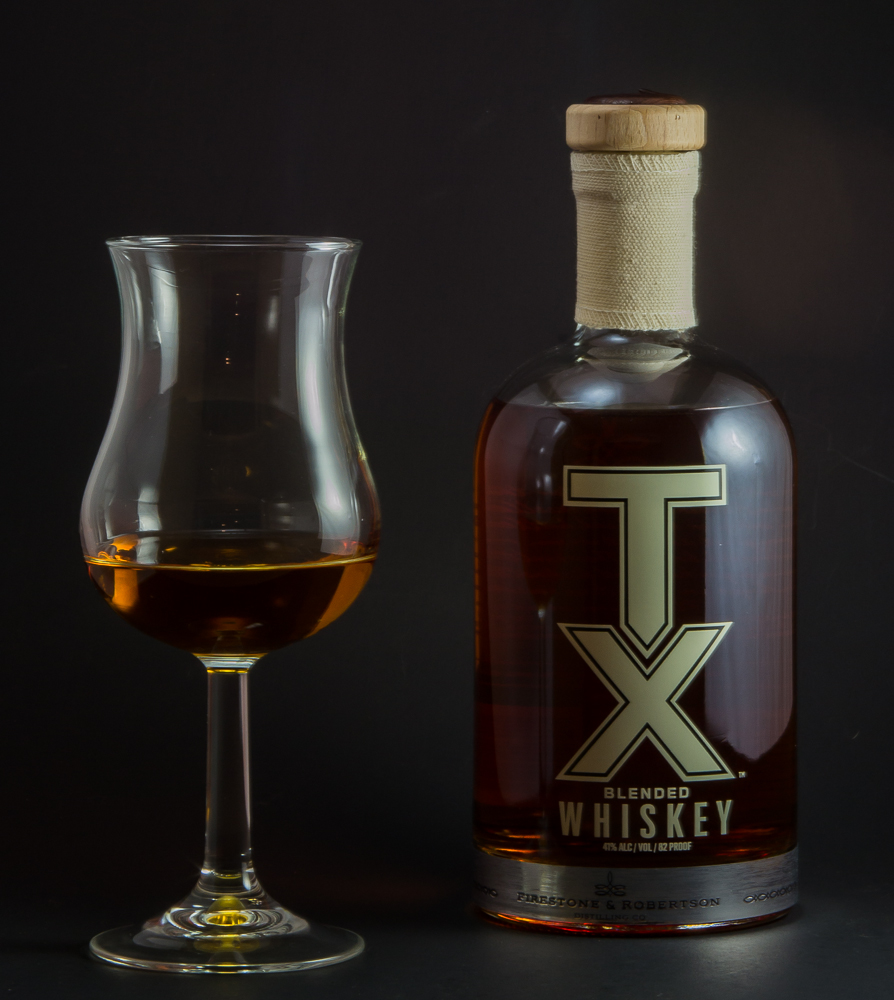
TX Blended Whiskey
Firestone and Robertson TX Blended Whiskey
Aged: Unknown
Nose: Strong pure vanilla
Body: Surprising sweet. More vanilla, this time ligthly infused with caramel.
Finish: Warm roasted marshmallows.
Activation: Muddles flavors while exposing little. Do not recommend.
Notes: This is the first American whiskey I have formally reviewed, hailing from none other than Fort Worth, Texas. It is crisp and clean like a highland malt might be, but as you might expect, more forward and straight-laced in its flavoring. TX Blended is easy to drink, and a solid opening move for American whiskies.

Bauchant Orange Liqueur - June 01, 2014
Bauchant is a remarkable blend of orange essence and French cognac. This bottle is proof that orange flavored liqueurs do not have to be disgusting.
Seriously, one taste of this fabulous drink and you will never buy triple sec or blue curacao ever again. Where these overly common mixers are usually
garishly colored, syrupy, and sickeningly sweet, Bauchant is subtle and refined without losing the characteristic orange flavor you are looking for.
It can replace any orange flavored liqueur in your favorite cocktails, or, due to some of the stronger and more herbal notes of the cognac, it can also be
substituted in for brandy as well. Really, once you start using it, you will find a place for this liqueur in everything.
Note: All drinks marked with an asterix are from external sources. Clicking on the drink name will take you to our references page.

The 7-Layer Shot
7-Layer Shot
Ingredients:
.25 oz Velvet Falernum
.25 oz Crème de Noyaux
.25 oz Crème de Violette
.25 oz Bauchant Orange Liqueur
.25 oz 100 Proof Peppermint Liqueur
.25 oz Overproof Rum
Instructions:
Put all ingredients except for the overproof and the peppermint into the freezer for an hour. Carefully, with the help of a spoon, layer the ingredients in the following order: Velvet Falernum, Crème de Noyaux, Crème de Violette, Limoncello, Orange Liqueur, 100 Proof Peppermint Liqueur, Overproof Rum.

The Chocolate Orange Cream
Chocolate Orange Cream
Ingredients:
1 oz Godiva Dark Chocolate Liqueur
1 oz Godiva Milk Chocolate Liqueur
1.5 oz Bourbon Cream
1 oz Bauchant Orange Liqueur
Instructions:
Combine all ingredients in a shaker and pour in a martini glass.

The Dandelion Dream
Dandelion Dream
Ingredients:
2.5 oz Gin
.25 oz Elderflower Liqueur
1.5 oz Bauchant Orange Liqueur
Instructions:
Combine ingredients and shake over ice. Serve in a martini glass.

The Morning Commute
Morning Commute
Ingredients:
1 oz Bauchant Orange Liqueur
1 oz Espresso Liqueur
Instructions:
Layer the espresso liqueur on the bottom and the orange liqueur on top. Pretend it's the sun rising over the city smog.
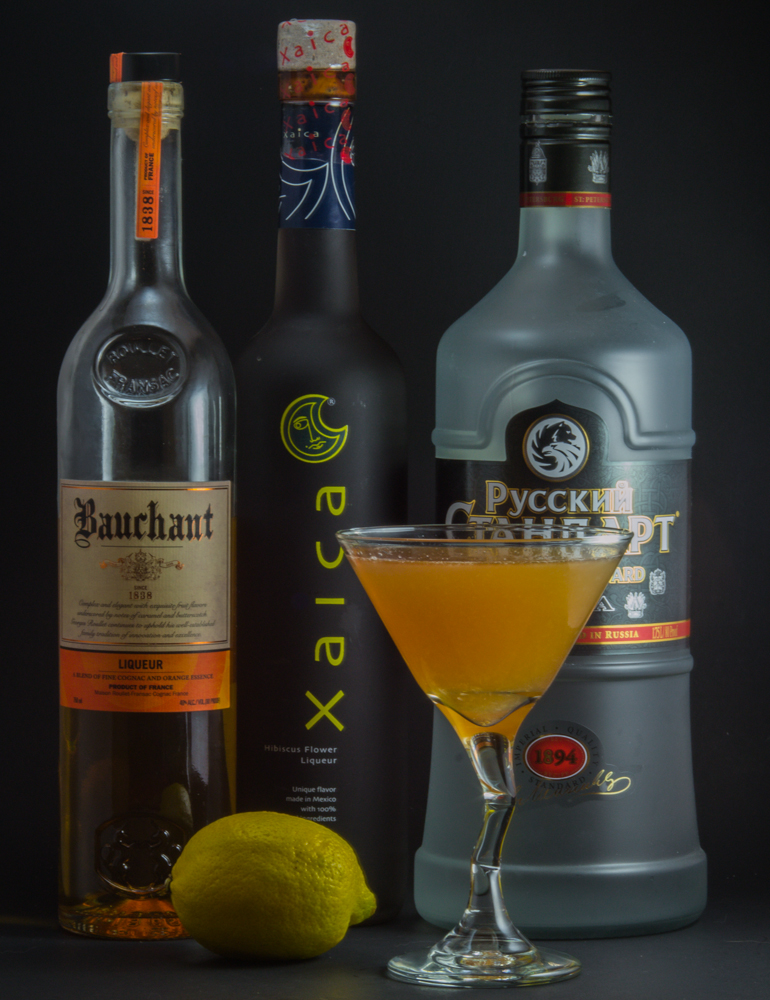
The Tangerine Dream
Tangerine Dream
Ingredients:
3 oz Vodka
.5 oz Lemon Juice
1 oz Bauchant Orange Liqueur
.75 oz Hibiscus Liqueur
Instructions:
Combine ingredients and shake over ice. Serve in a martini glass.

Black Rum - June 29, 2014
By Chris
Here at the Elektra, our Drink of the Month segment makes a point to highlight liqueurs that the average individual may not have come across in a generic restaurant
menu. We steer clear of cocktail bases such as gin or vodka. This is quite simply because there are so many options and the differences can be so subtle that we cannot
hope to cover them all in our usual format. However, we realize that a cocktail is only as good as its base, and as such, we have started a multipart guide to choosing
the perfect liquor for whatever your end goal may be. Our first such segment will deal with one of the most varied spirits- rum.
We have decided to start from the top, as it were, with overproof rum. 'Overproof' is a generic term that means exactly what you think- this bottle contains a higher alcohol
content than is normal for this particular spirit. Depending on the spirit type, overproof can also be called a lot of things, such as navy strength or distiller's strength.
However, in the world of rum, the most frequent moniker is 151. In fact, if you ask for 151, the fact that you are referring to overproof rum is assumed. As you might expect,
151 refers to the proof of the rum. Today, proof is legally defined as 2 x ABV, or alcohol by volume; thus our 151 is 75.5% alcohol. Interestingly enough, this was not always
the case. In the 18th century, British sailors' pay included a ration of rum. However, they demanded 'proof' that their ration had not been watered down or diluted. To ensure
that their rum was still strong, they would pour the rum onto a small amount gunpowder and attempt to light it. Any liquid that was less than 57.15% alcohol would not burn, so
this percentage was set to '100 proof'. 100 proof was approximately 7/4 times the ABV, so for a long time proof was equal to ABV x 7/4. However, in more recent years, this
ratio has been simplified to 2, making finding the proof of a spirit very easy to do mentally. To avoid confusion because of these differing standards, all alcohol sold in the
United States must be labeled with the ABV. It is permitted, but not required, to also state the proof.
In any case, I wondered what was so special about 151 specifically. Why not 150 proof rum, or 155? As it turns out, several states (though not Texas) prohibit the selling of
any spirit that is stronger than 75.5% ABV. Thus, in order to give their products the widest appeal possible, most distillers limit their rum to 151 proof so that it may be sold
in any state. And trust me when I say that for any consumption purpose, this is more than enough. Remember that our sailors could burn alcohol at 57.15% ABV, so 75.5% is very
strong, and quite flammable.
Indeed, the main use of 151 is to add a dramatic flair to a cocktail. The high alcohol content gives it a low density, ensuring that it will float easily on top of just about any
mixture. The thin layer of rum is then ignited, and most of it will burn off very rapidly. The remaining cocktail can then be drank without dramatically altering its overall proof.
You never want to taste the 151 itself. For example, taking one shot of this potent liquor will probably be enough to make you sick, and will certainly burn your throat and tongue
on the way down. In light of this, it doesn't really matter which brand of 151 you use. We have tried both the Bacardi and the Cruzan variants and found them to be virtually
indistinguishable. All things equal, the Bacardi bottle is easier to pour from, so that is the one I would recommend.
Check out some of our fiery favorites below. Flaming drinks are fun addition to any party or get together. Of course, always use some good common sense when trying this at home.
Never consume the drink while it is still burning, and don't let the glass burn for more than several seconds because overheated glass can shatter. Happy mixing!

The Bailey's Comet
Bailey's Comet*
Ingredients:
.25 oz Overproof Rum
.5 oz Goldschlager
.5 oz Bailey's Irish Cream
Instructions:
Layer the Irish Cream on bottom, the Goldschlager in the middle, and the overproof on top. Ignite the overproof and sprinkle with cinnamon to create a tail.
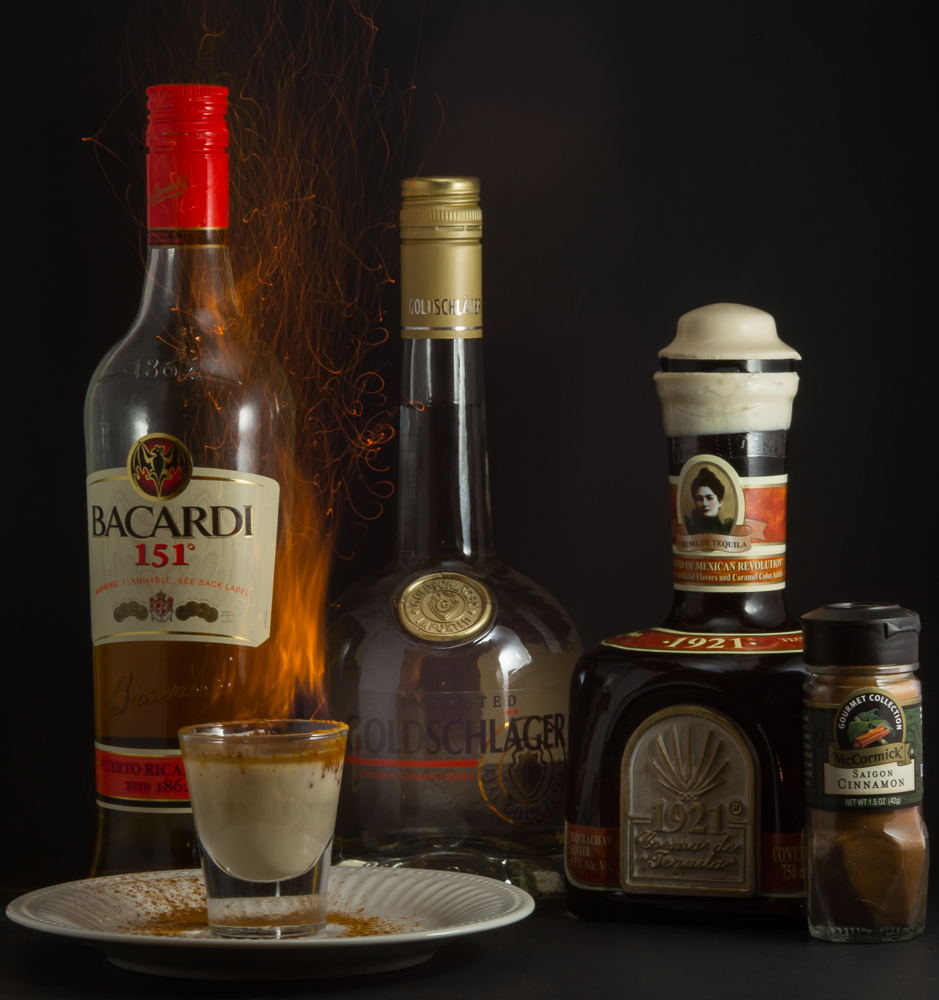
The Maria's Comet
Maria's Comet
Ingredients:
A Pinch Cinnamon
.5 oz Goldschlager
.5 oz Crema de Tequila
.25 oz Overproof Rum
Instructions:
Layer crema de tequila, Goldschlager, and 151 in a shot glass. Ignite beverage with a lighter and sprinke in cinnamon to produce the comet tail.

The Rum Cake
Rum Cake
Ingredients:
.25 oz Overproof Rum
1.5 oz Black Rum
.25 oz Allspice Liqueur
.75 oz Nassau Royale
.75 oz Butterscotch Liqueur
Instructions:
Combine all ingredients except for the overproof in a shaker and pour in a martini glass . Float the overproof rum and ignite.

Dalmore Clan Mackenzie Collection - May 09, 2014
By Chris
All whiskey tells a story. Whiskey does not roll off of an assembly line. Rather, it is slowly aged to perfection in a painstaking process
that cannot be hurried, compromised, or tampered with. The textures of the grains and malts tell the story of the land, the people, and the time
from whence they came. Each wooden cask used for aging or finishing will add its own chapter to the story, and the process followed is as important
as the ingredients used. Every years bottling is unique, which is why the year on the label represents the youngest of the malts used: some components
will be far older than that, mixed together to impose continuity over time.
Our story today, however, begins not with malt or an oak, but with a hunt. In 1263, King Alexander III of Scotland was out hunting deer when he came across
an enormous 12-point buck. The king’s horse reared and he was thrown to the ground. The stag lowered its head and would have gored the king had not a young
commoner named Colin Fitzgerald leapt into action and slew the beast. The grateful king named the man Earl of Cromartie and gave him permission to bear the stag’s
head as his coat of arms. The man went on to become the head of Clan Mackenzie, the clan which founded what would eventually become the Dalmore distillery.
To this day, every bottle of Dalmore produced bears the 12-point stag.
Richard Patterson, master distiller at Whyte and Mackay, has created a three part series of whiskies to commemorate these events and to raise funds for the
renovation and historical preservation of Clan Mackenzie’s estate and properties. Three bottles: the clan, the castle, and the land. Each bottle is aged more
than 15 years and each tells its own part of the story of a noble people that have protected the land for more than 700 years. These are rare malts indeed, and
it is a privilege and an honor to present them to you.
Wherever your own expeditions may take you, I implore you to remember: all whiskey tells a story. You have but to listen.

The Dalmore Clan Mackenzie Collection
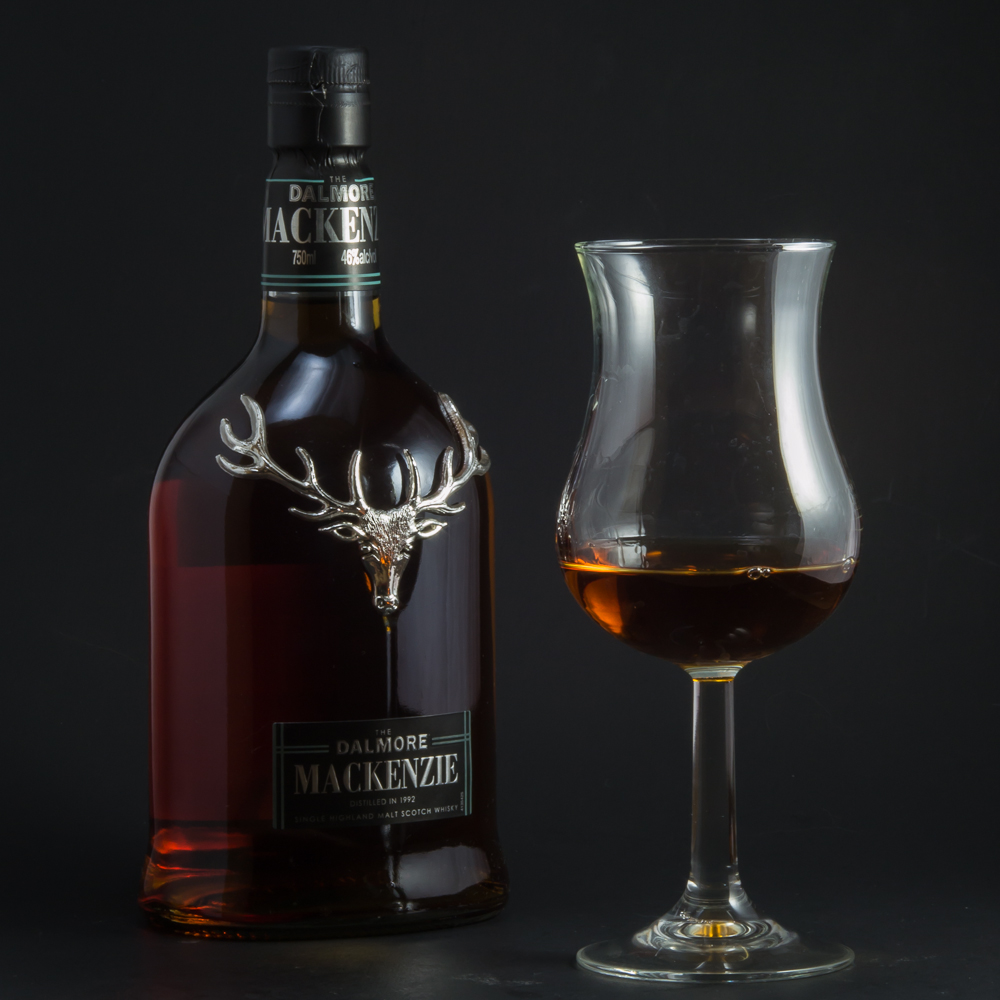
The Dalmore Mackenzie
Here, for convenience, are the tasting notes and comments for the 3 pictured scotches.
Dalmore Mackenzie
Aged: 11 Years in American white oak, then 6 in Oporto port wine
Nose: Warm and complex. Tones of ripe citrus and plums.
Body: Rich and supple. More plum, followed closely by mango. Undertones of ginger throughout.
Finish: Fleeting taste of almonds gives way into very bitter chocolate.
Activation: Dulls some of the sweetness, lending a saltier character instead. More nuts and less fruits. Would generally avoid.
Notes: The Mackenzie is the first bottle in this historic series, and at only 3,000 total bottles, the rarest as well. As you might expect from a whiskey with an incredible six years finishing in wine casks, this malt is rich and luxurious, with no harsh peats or rough edges at all. It relies quite heavily on warm and fruity flavors, but never feels washed out or overpowered by them. A truly remarkable whiskey with more to offer on each subsequent tasting. Save this one for special occasions.
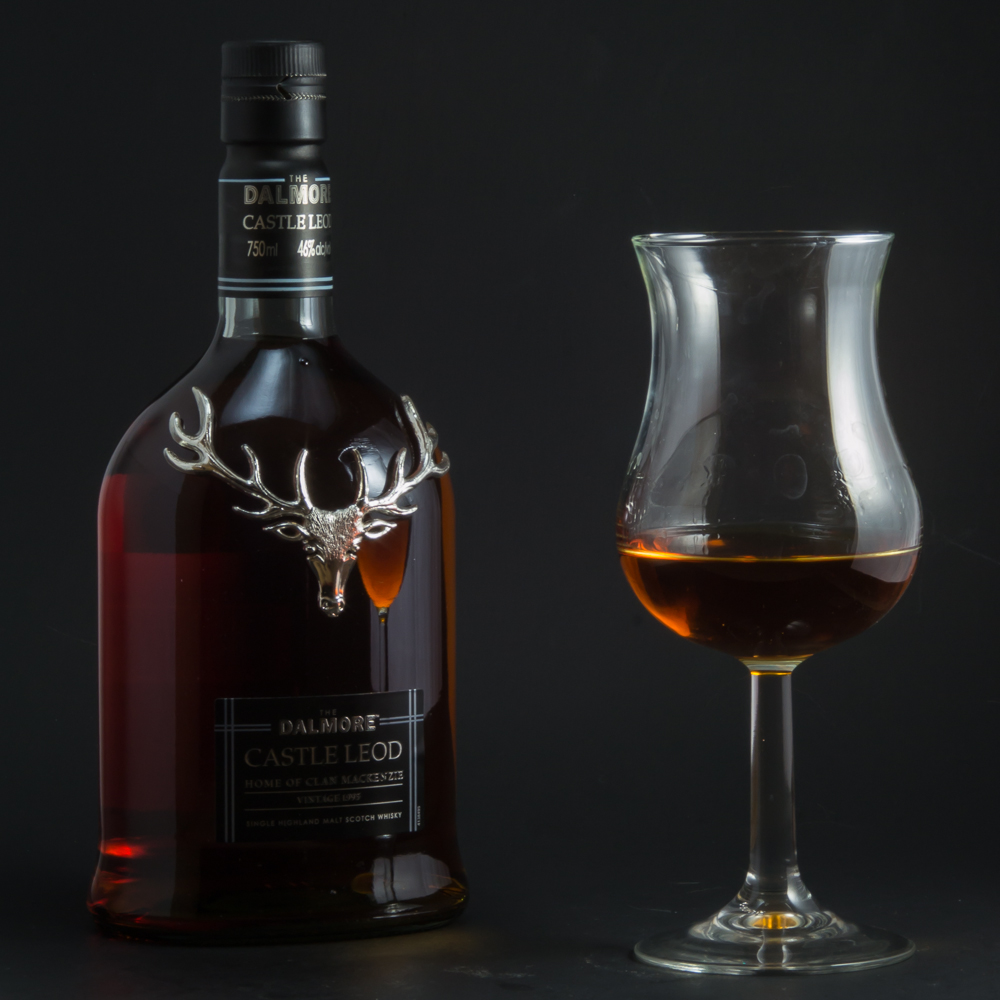
The Dalmore Castle Leod
Dalmore Castle Leod
Aged: 14 Years in American white oak, then 18 months in Bordeaux chateau.
Nose: Powerful aromas of grapes, raisins and pears.
Body: Ripe fleshy plums and fainter pears slowly give way to honey and caramel.
Finish: Resurgence of plum and dark berries, with just a hint of licorice
Activation: Adds a lighter note, including more citrus flavors. Both are good.
Notes: The Castle Leod, second in the series, is probably the most accessible of the bottles. Another smooth and well rounded bottle, it has an elegant simplicity that belies the actual age of this whiskey. It isn't as stunning as the Mackenzie, but it is a good, light hearted malt that will not disappoint.
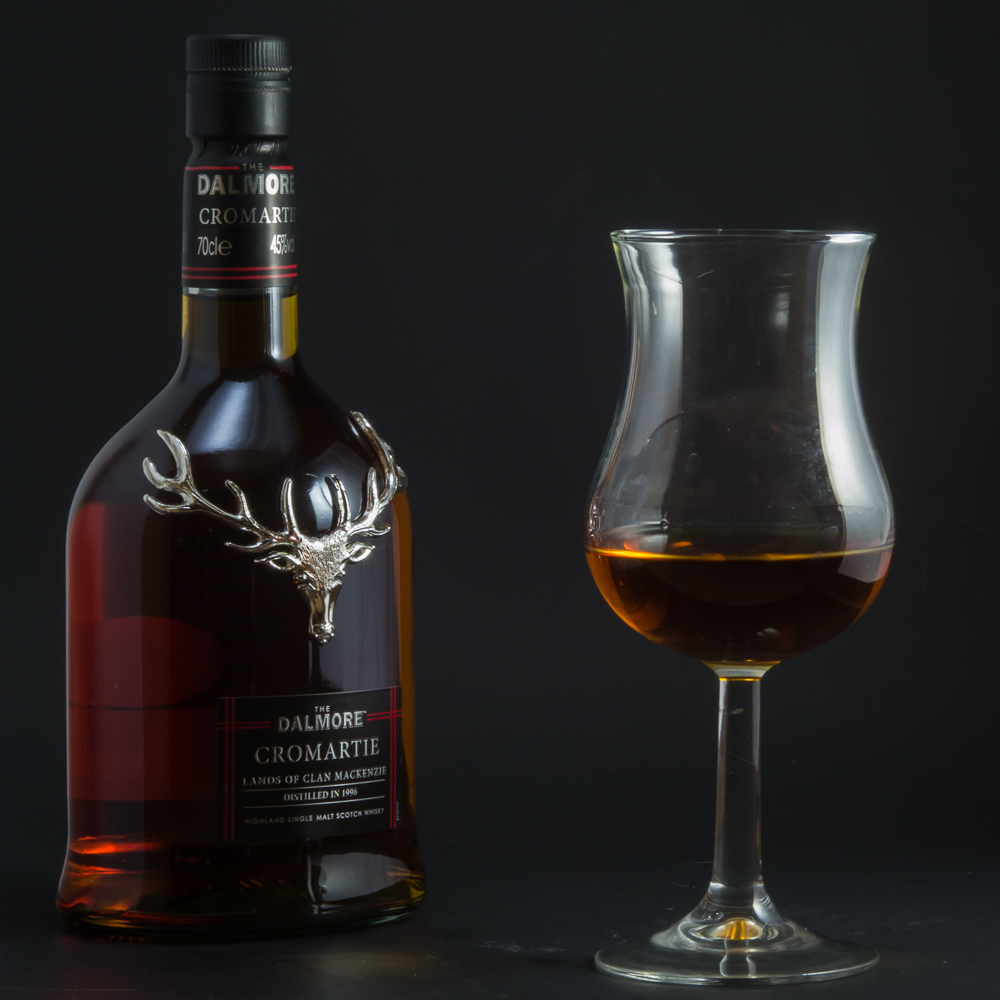
The Dalmore Cromartie
Dalmore Cromartie
Aged: 14 Years in American white oak, then 18 months in Oloroso sherry.
Nose: Dark chocolate with faint layers of citrus and berries.
Body: Sweet and spicy. More orange-infused chocolate, coupled with cinnamon and a hint of cloves.
Finish: Dark Columbian coffee and mocha fade away into citrus and grapes.
Activation: Lightens the character. The dark velvety notes are replaced by sharper lemons and grapes. Would recommend.
Notes: The third and final expression of the series is something of a tough nut to crack. At first tasting, the flavors feel somewhat muddled and lacking in direction. Subsequent trials, however, yield more clarity and complexity, especially with the addition of spring water. In short, it is not a dram to be hurried or taken lightly.
